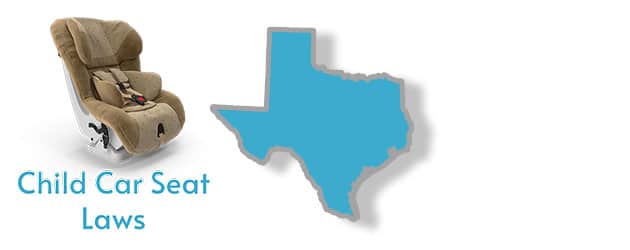A Summary of Child Car Seat Laws in Texas
A Summary of Child Car Seat Laws in Texas
- Infants and toddlers should ride on rear-facing seats until they reach age 2.
- Children can graduate to forward-facing seats once they outgrow the rear-facing seat.
- Children can ride on booster seats once they outgrow forward-facing seats.
- The law requires children younger than 8 years to be restrained with a child safety seat system unless they are 4’9’’ or taller.
- Children can legally stop using booster seats once they reach age 8 or a height of 4’9’’.
- Children should remain in the rear seat until age 13.
Rear-facing Car Seat Laws in Texas
According to the Texas Department of Transportation, infants and toddlers should ride on rear-facing seats until they reach age 2 or until they exceed the height and weight requirements set by the manufacturer. Children need to remain in the rear-facing position because it is the safest. During a car crash, the back of the seat cradles the baby and absorbs the crash forces, thus protecting the baby’s fragile head, neck, and back. Ensure the harness straps are snug over your child’s body in such a way that you cannot pinch extra strap material over the baby’s shoulder. The most common types of rear-facing seats are infant-only and convertible seats. Infant-only seats are suitable for newborns and are used for a short period of time, after which the child transitions to convertible seats. Convertible seats have higher weight limits (up to 40 pounds), allowing children to continue riding on them until age 4. Rear-facing seats should be installed in the back seat according to the manufacturer’s instructions.
Forward-Facing Car Seat Laws in Texas
Children can graduate to forward-facing seats with a 5-point harness once they outgrow the rear-facing seat. Children should remain in forward-facing seats until they exceed the manufacturer’s topmost weight and height limit. The hip and shoulder straps should be snugly secured. This helps in directing crash forces away from the child’s fragile body parts and spreads them over the stronger and more mature parts (shoulders and hips). A forward-facing seat can be installed with lap-shoulder belts, lap-only belts, or a latch system. If your child has exceeded the rear-facing requirements, you can turn the convertible seat to face forward. Forward-facing seats can support children of up to 65 pounds, so this means children can safely ride on them until age 7. Seats of this type should always be installed in the back seat according to the manufacturer’s instructions.
Booster Seat Regulations in Texas
Children can ride on booster seats once they outgrow forward-facing seats. Typically, this happens between the ages of 4-8 years. The law requires children younger than 8 years to be restrained with a child safety seat system unless they are 4’9” or taller. This means children can legally stop using booster seats once they reach age 8 or a height of 4’9”. Belt-positioning booster seats are used to lift a child so that regular safety belts can fit over the child’s body. The design of the booster seat helps position the lap belt across the upper thighs and the shoulder across the center of the chest area. Booster seats come in two types – high back and backless. High back booster seats support a child’s head and neck when there are no headrests in the rear seats while backless are used when the headrests are available. Booster seats are normally secured with lap-shoulder belts. Never use a lap-only belt. Most seats can support up to 80 pounds, therefore children can still be within the seat’s limits until age 12, depending on their growth rate. However, the best practice is to transition your child to safety belts when they can fit in them. Typically, this happens when the child is 4’9” or taller. A seat belt ready child should also be able to sit straight up against the back of the seat and with knees bent at the edge of the seat.
Requirements for children to use the front seat in Texas
The Texas Department of Public Safety recommends children should remain in the rear seat until age 13. The back seat is considered to be the safest position because there are no airbags, and it’s also farther away from the point of impact in the event of a frontal impact. It is illegal to place a rear-facing seat in the front seat without turning off the passenger-side airbag.
Law on leaving a child in a car in Texas
It is illegal to leave children unsupervised inside a car for more than 5 minutes. Exceptions apply when he or she is accompanied by someone 14 years or older. We recommend to never leave your child unattended for any length of time.
Law on Smoking in a car with a child in Texas
It is considered a petty offense to smoke in a car with a child passenger.
Car Seat Law Exemptions in Texas
Commercial vehicles such as taxis and cars for hire are exempted from complying with the state’s car seat laws. Also exempted are passengers riding in cars when all seating positions equipped with safety belts and child safety seats are occupied.
Law on Car Seat Replacement in Texas
There are no laws that cover the replacement of car seats. However, you should replace your car seat after a major or moderate accident. Also, car seats usually expire, so check your seat’s expiry date.
More Texas Laws
